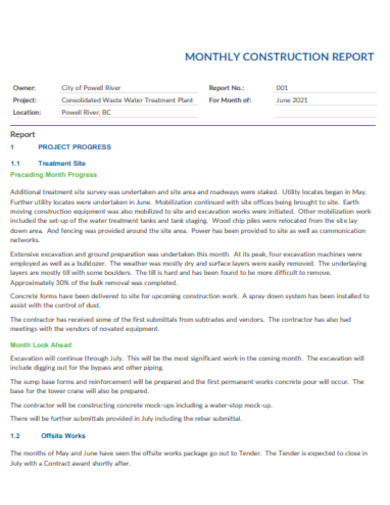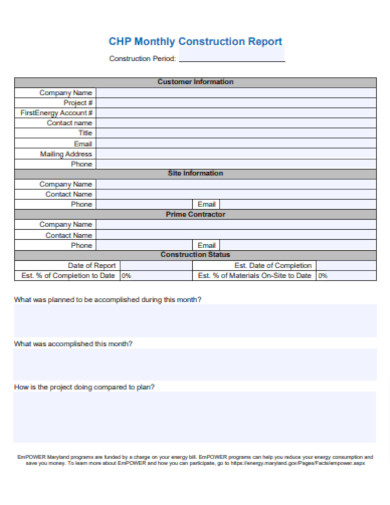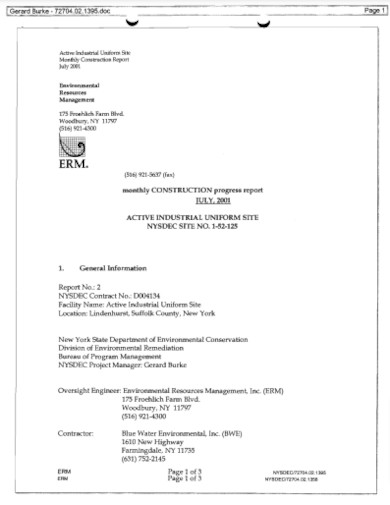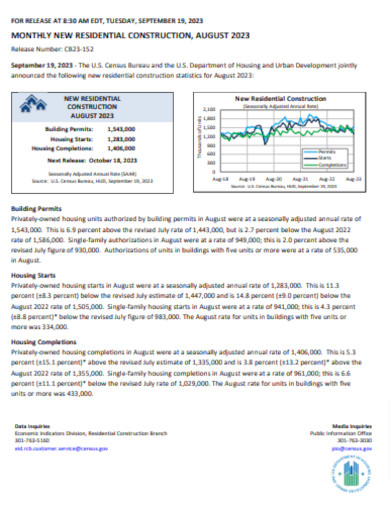25+ SAMPLE Monthly Construction Report
-

Monthly Construction Progress Report
download now -

Monthly Contractor Construction Safety Statistic Report
download now -

Sample Monthly Construction Progress Report
download now -

Simple Monthly Construction Report
download now -

Monthly Board Construction Report
download now -

Printable Monthly Construction Report
download now -

Monthly Construction Project Manager Report
download now -

Monthly Construction Contingency Report
download now -

Basic Monthly Construction Report
download now -

Monthly Construction Project Progress Report
download now -

Monthly Construction Residential Report
download now -

Monthly Construction Inspection Report
download now -

Monthly Construction Project Report
download now -

Monthly Construction Situation Report
download now -

Editable Monthly Construction Report
download now -

Monthly Construction Managers Report
download now -

Blank Monthly Construction Report
download now -

Monthly Construction Report Outline
download now -

Monthly Construction Budget Report
download now -

Monthly Construction School Report
download now -

Monthly Construction Inspector Report
download now -

Monthly Construction Building Report
download now -

Monthly Construction Report Layout
download now -

Monthly Construction Activity Report
download now -

Monthly Construction Safety Report
download now -

Monthly Construction Report Format
download now
FREE Monthly Construction Report s to Download
25+ SAMPLE Monthly Construction Report
Definition:
Understanding the Significance of a Monthly Construction Report:
Key Components of the Report:
The Relevance of Consistent Reporting:
Leveraging Technology in Reporting:
Implementing Feedback:
The Future of Monthly Reporting:
Why is it essential for stakeholders to review construction reports on a monthly basis?
How does the monthly construction report detail resource allocation and usage?
What section on future recommendations or action plans are essential in the monthly report?
When should a monthly construction report be submitted to stakeholders?
Can a monthly construction report be used to forecast future challenges or needs?
Are subcontractor performances and contributions detailed in the monthly report?
Definition:
A Monthly Construction Report is a comprehensive document detailing the progress, challenges, financial status, and resource utilization of a construction project over a month. It serves as a transparent communication tool for stakeholders, offering insights into the project’s pace, budget adherence, safety compliance, and any potential bottlenecks or issues that may arise.
Understanding the Significance of a Monthly Construction Report:
Delving into the intricacies of construction management, the Monthly Construction Report emerges as a pivotal tool. It not only offers a snapshot of the ongoing work but also acts as a barometer, indicating the health and pace of the project.
Insightful Overview:
Monthly construction reports provide stakeholders with a comprehensive view of the project’s status. These reports encapsulate the progress, challenges, financials, and other pertinent details over a month, enabling clear visibility and decision-making.
Accountability and Transparency:
By documenting accomplishments, issues, and expenses, these reports establish accountability among the project team and maintain transparency with stakeholders.
Data-Driven Decisions:
Monthly metrics on labor, costs, material usage, and more, enable stakeholders to make informed, data-driven decisions, ensuring that the project remains on track.
Risk Management:
Potential risks, safety incidents, or compliance issues highlighted in the report can be addressed promptly, preventing larger complications.
Stakeholder Communication:
Consistent reporting fosters trust and open communication between the project team and investors, clients, or partners. It keeps everyone aligned on expectations, achievements, and the roadmap ahead.
Review and Planning:
At the month’s end, analyzing the report helps in evaluating performance, learning from challenges, and setting objectives for the upcoming month, ensuring continuous improvement.
Key Components of the Report:
Every construction report is unique to its project. However, certain elements remain universal:
Project Overview:
This section provides a brief summary of the project, including its current status, milestones achieved during the month, and any significant changes or developments.
Financial Summary:
A detailed breakdown of monthly expenditures, budget allocations, and financial projections. It offers insights into areas where spending was over or under budget.
Progress Against Schedule:
This component highlights the tasks completed during the month, comparing actual progress to the planned schedule. Any deviations or delays are noted, with reasons.
Material and Equipment Update:
An inventory of materials used, those remaining, and the status of equipment. This can also include details on any material procurements or equipment malfunctions.
Safety and Compliance:
A record of safety incidents, near misses, and compliance checks carried out during the month. Any corrective actions taken can also be included.
Upcoming Activities Forecast:
A look-ahead into the next month’s planned activities, tasks, and objectives. It prepares stakeholders for what’s to come and allows for any necessary resource adjustments.
Stakeholder Communication:
Summaries of meetings, decisions made, and feedback received from stakeholders. This ensures all parties are aligned and informed.
Recommendations and Action Items:
Based on the month’s progress and challenges, this section lists recommended actions or changes to ensure the project remains on track.
The Relevance of Consistent Reporting:
Consistency in reporting ensures a steady flow of information, which is vital for project management. Regular updates keep stakeholders informed, facilitating swift decision-making and preemptive action against potential pitfalls.
Why Consistency Matters:
Consistent reporting in construction ensures that all stakeholders remain informed and aligned. It establishes a routine flow of information, allowing for better planning, decision-making, and resource allocation. Consistency also helps in identifying trends or patterns which can be crucial for proactive problem-solving.
Enhancing Transparency:
Consistency in reporting ensures that all facets of the construction project, be it progress, finances, or challenges, are transparently presented to stakeholders. This fosters trust and enables stakeholders to make well-informed decisions.
Enabling Proactive Decision Making:
When stakeholders receive regular updates, they can make proactive decisions. Whether it’s reallocating resources, revising strategies, or addressing challenges, consistent reporting provides the data needed to make these decisions promptly.
Benchmarking and Continuous Improvement:
Consistent reports provide a historical record, allowing teams to compare current performance against past data. This benchmarking is invaluable for continuous improvement, helping teams identify areas of strength and those needing enhancement.
Streamlining Communication:
Regular reporting ensures that all parties, from site workers to investors, receive the same information. This streamlines communication, reducing misunderstandings or misinterpretations, and ensuring everyone is on the same page.
Risk Mitigation:
Consistent insight into a project’s status helps in early detection of potential risks or challenges. Early identification means early resolution, reducing the chances of these challenges escalating into bigger problems.
Leveraging Technology in Reporting:
The digital age has ushered in several tools and software that can make the process of generating these reports more efficient. From cloud-based storage systems to data analytics tools, technology can greatly enhance the accuracy and utility of the Monthly Construction Report.
Embracing Digital Transformation:
The construction industry, traditionally seen as slow to adapt, is increasingly leveraging technology. Digital transformation in reporting enhances accuracy, efficiency, and accessibility.
Real-time Analytics:
Advanced software tools process data instantaneously, offering real-time insights into project progress, resource allocation, and financials. Stakeholders no longer have to wait for end-of-month reports to understand the project’s current status.
Enhanced Visualization:
Technologies like augmented reality (AR) and virtual reality (VR) are being used to provide immersive visual reports. This allows stakeholders to virtually “walk” through construction sites or view 3D representations of project progress.
Cloud-based Accessibility:
Cloud-based reporting tools ensure that reports are accessible anytime, anywhere. Whether on-site or in a boardroom halfway across the world, stakeholders can access up-to-date reports through mobile devices or computers.
Integration Capabilities:
Modern reporting tools seamlessly integrate with other software solutions used in construction, such as project management tools, accounting software, or resource allocation tools. This ensures a unified platform for all construction-related activities.
Enhanced Security:
Digital reports are often more secure than their paper counterparts. Encrypted storage, secure access controls, and regular backups ensure that sensitive project data remains confidential and protected from potential loss.
Streamlined Communication:
Digital reports often come with features that allow annotations, comments, or real-time discussions. This facilitates quicker feedback loops and more efficient communication among stakeholders.
Predictive Analysis:
Advanced reporting tools leverage artificial intelligence (AI) and machine learning (ML) to predict future trends based on current and past data. This predictive analysis can be invaluable in proactive problem-solving and forward planning.
Implementing Feedback:
Always encourage feedback on the report. Whether it’s from the construction team, stakeholders, or clients, constructive feedback can refine the reporting process, making it more tailored to the needs of the project.
The Importance of Feedback:
Feedback on monthly construction reports can offer invaluable insights, driving improvements in project management and reporting accuracy. Recognizing this importance can lead to more informed decision-making.
Gathering Constructive Criticisms:
Actively solicit feedback from various stakeholders, ensuring a comprehensive understanding of the report’s strengths and areas for enhancement.
Analyzing the Feedback:
Once gathered, categorize feedback, looking for common themes or suggestions. This helps prioritize necessary changes and updates.
Tailoring Content to Stakeholder Needs:
Adjust the report content based on who will be reading it. If financial stakeholders desire more budgetary details, or if the onsite team needs more clarity on progress, modify accordingly.
Continuous Feedback Loop:
Establish a regular feedback mechanism, so that each report is better than the last. This keeps the reporting process dynamic and responsive to evolving project needs.
Implementing Changes for Future Reports:
Using the feedback, make necessary amendments in data gathering, analysis, and presentation. Ensure these changes reflect in subsequent reports for consistent improvement.
Communication and Transparency:
Inform stakeholders about the changes made based on their feedback. This promotes trust and encourages them to provide future feedback.
Training and Workshops:
If feedback indicates misunderstandings or gaps in knowledge, consider organizing workshops or training sessions. This can help the team understand the report’s intricacies and importance better.
The Future of Monthly Reporting:
With the digital revolution underway, construction reports are increasingly becoming more interactive. Tools like Building Information Modeling (BIM) and project management software are integrating with reporting processes, making them more dynamic and real-time.
Embracing Digital Transformation:
The integration of advanced digital tools and software will make monthly reporting more automated, accurate, and real-time. Tools like AI and machine learning can predict trends and analyze vast amounts of data efficiently.
Real-time Analytics and Insights:
Instead of waiting for month-end, advanced systems will offer real-time insights, allowing for immediate adjustments. This ensures projects stay on track and within budget, reducing month-end surprises.
Integration with Other Systems:
Future monthly reports will seamlessly integrate with other enterprise systems, offering a holistic view of a project’s status, from finance to manpower and materials. This ensures consistent and comprehensive data sourcing.
Enhanced Visual Representation:
The future of reporting lies in visually rich presentations, such as interactive dashboards and 3D visualizations. This allows stakeholders to understand complex data intuitively and make informed decisions faster.
Collaborative Reporting Platforms:
Cloud-based platforms will allow teams to collaborate on reports in real-time, ensuring that inputs from various departments are included and reducing the chances of discrepancies or omissions. This fosters transparency and team alignment.
Why is it essential for stakeholders to review construction reports on a monthly basis?
Reviewing construction reports monthly allows stakeholders to monitor project progress, ensure budget adherence, and identify potential issues early. This regular oversight promotes timely decision-making, facilitates resource allocation, and reinforces accountability, ensuring the project remains on track and in alignment with the established goals and timelines.
How does the monthly construction report detail resource allocation and usage?
The monthly construction report provides a breakdown of resources, including manpower, equipment, and materials. It details their allocation across various tasks, actual usage versus planned, and any discrepancies or overages. This offers stakeholders a clear view of resource efficiency, highlighting areas of optimization or potential wastage, ensuring cost-effective project execution.
What section on future recommendations or action plans are essential in the monthly report?
In the monthly report, the Future Recommendations or Action Plans section is pivotal. It should include insights from the past month’s performance, suggest corrective actions for identified issues, and provide proactive measures to mitigate potential risks. This section ensures continuous improvement and adaptive planning, optimizing project execution and stakeholder confidence.
When should a monthly construction report be submitted to stakeholders?
A monthly construction report should be submitted to stakeholders shortly after the month’s end, typically within the first week of the subsequent month. This ensures stakeholders receive timely and relevant insights on project progress, challenges faced, and any corrective actions planned, allowing for informed decision-making and proactive intervention.
Can a monthly construction report be used to forecast future challenges or needs?
Yes, a monthly construction report can be used to forecast future challenges or needs. By analyzing trends, resource consumption, and past issues, the report can predict potential obstacles and resource requirements, enabling proactive planning and allowing stakeholders to address concerns before they escalate, ensuring smoother project progression.
Are subcontractor performances and contributions detailed in the monthly report?
Yes, subcontractor performances and contributions are typically detailed in the monthly report. This provides transparency on each subcontractor’s role, progress, and efficiency. Highlighting their achievements or areas of improvement ensures accountability and helps in evaluating and managing the overall health and timeline of the construction project.
In conclusion, the monthly construction report is an indispensable tool for project stakeholders, ensuring transparency, accountability, and efficiency in construction processes. By encapsulating key performance metrics and challenges faced, this report facilitates informed decision-making, ultimately bolstering project outcomes. Harnessing its insights can significantly elevate construction management standards and drive project success.
